 Ed Halter
Ed Halter
Circuits, microchips, robotics: thirteen new works by the artist created with the assistance of digital technology.
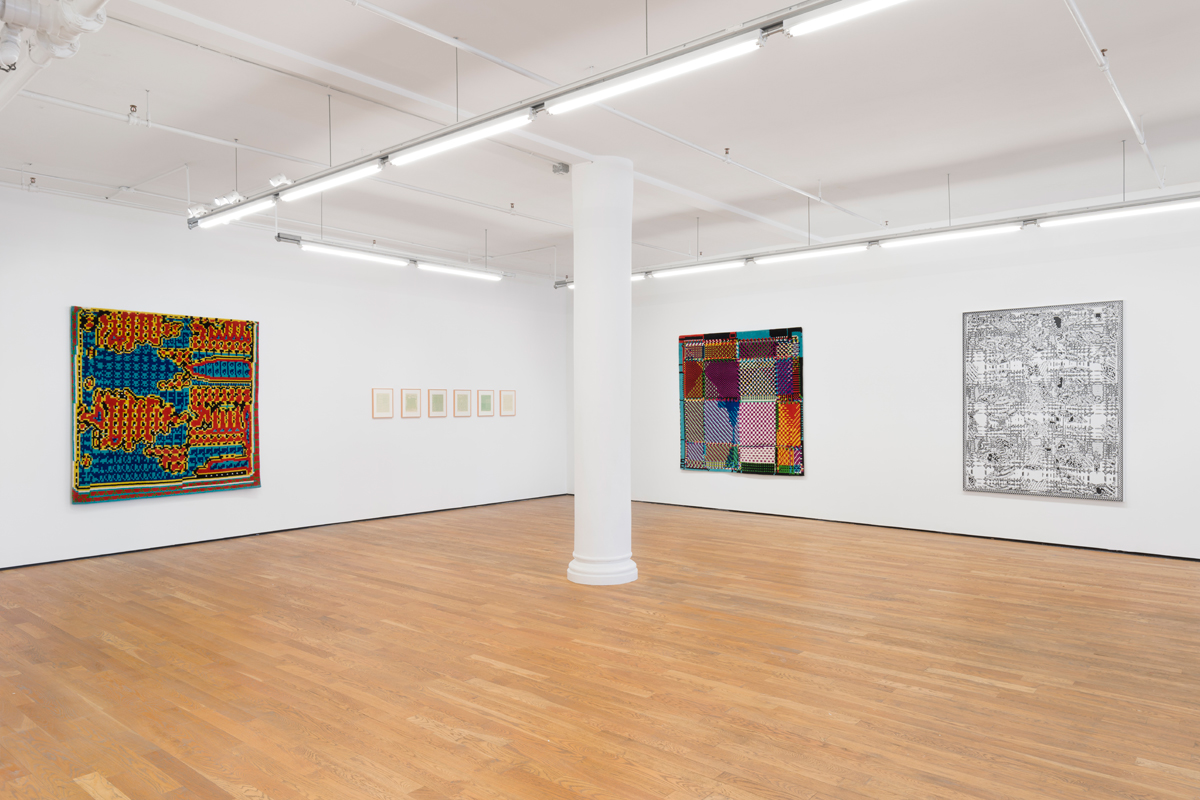
Travess Smalley: Number colors burn randomly, installation view. Courtesy the artist and Foxy Production. Photo: Charles Benton.
Travess Smalley: Number colors burn randomly, Foxy Production, 2 East Broadway, 200, New York City, through April 30, 2023
• • •
Travess Smalley’s new solo exhibition at Foxy Production contains a series of exquisitely noisy, blotchy grids, executed in a variety of dimensions and media. Two appear on thick, multicolored rugs, each six feet square and wall-mounted, like paintings; alongside these are three imposing white canvases, spidered with quavering lines of black pigment; and, near the corner of one wall, a set of six smaller grids, printed with foil on letter-size cream paper, hang together in a polite row. The various densities and scales of messy crisscrosses in the room almost suggest that each piece, when examined microscopically, might prove to be a magnified portion of another. A bit off on their own sit two video monitors, whose ever-shifting animations picture bouquets and fields of crudely rendered flowers.
Number colors burn randomly, the show’s title, at first sounds like an echo of Noam Chomsky’s famous phrase Colorless green ideas sleep furiously, coined by the linguist in 1957 as an example of a sentence that is syntactically perfect and yet nonsensical. Smalley’s exhibit takes its name from a line of poetry the artist composed in 2019 using the results of a predictive text program that had been trained, according to his introduction to the poem, on “data sets of old english flower names, articles on shades of green, ultraviolet plant photography, and computer scripts I’ve created.”

Travess Smalley: Number colors burn randomly, installation view. Courtesy the artist and Foxy Production. Photo: Charles Benton. Pictured: Terrainstamp, 2023.
The awkward title has a contemporary ring. The wonky meaninglessness of an otherwise well-structured utterance is one that we’ve all come to appreciate, thanks to our long interactions with spammers, bots, and, now, AI extrusions like ChatGPT, all pattering a half-ugly, half-beautiful computerfied language upon which we project an autonomous subjectivity struggling to coalesce. With relatively little data, Smalley produced and selected a phrase that nonetheless bears a good deal of poetic meaning: “number colors” could be read as a play on the hexadecimal codes that generate HTML colors, or similar systems in other programming languages; “burn” could mean to make manifest, as in burning a CD, or an image burning into a screen; “randomly” both describes the semantic style of its own sentence and refers back to the chance operations that determined its specific form.
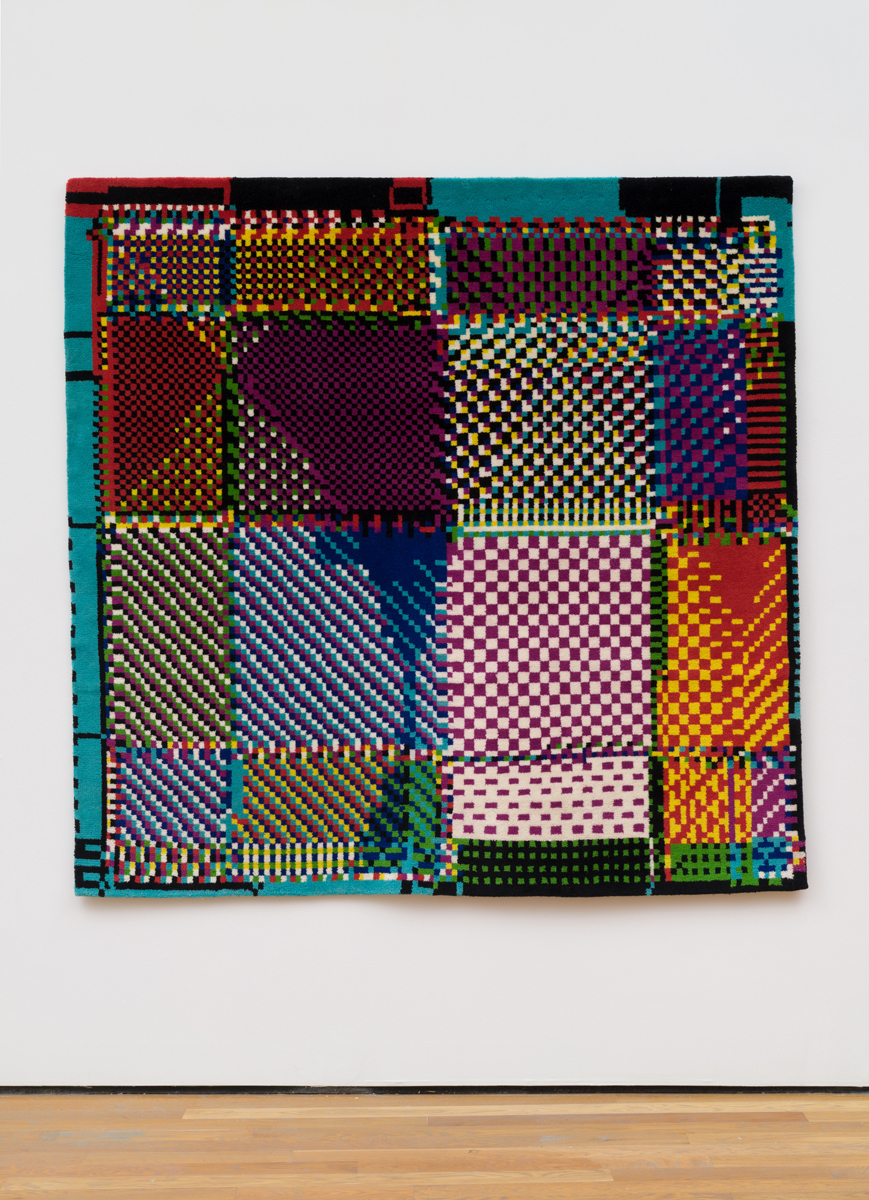
Travess Smalley, Ditherwave, Pixel Rug, 2023. Courtesy the artist and Foxy Production. Photo: Charles Benton.
The title also draws central attention to Smalley’s vibrantly hued carpets, whose combined seventy-two square feet of wool dominates a room otherwise populated by black-and-white screen prints, monochrome drawings, and pastel animations (all 2023). Ditherwave, Pixel Rug presents a frisky patchwork of different-size fields, each filled with kaleidoscopic micro-checkerboards. Rippleshift, Pixel Rug uses relatively few colors: convoluted polygons of mottled blue challenged by red growths that glow with yellow-black borders, the whole reminiscent of a low-resolution heat-map, or one frame saved from a particularly gnarly session with an early ’70s analog video synthesizer.
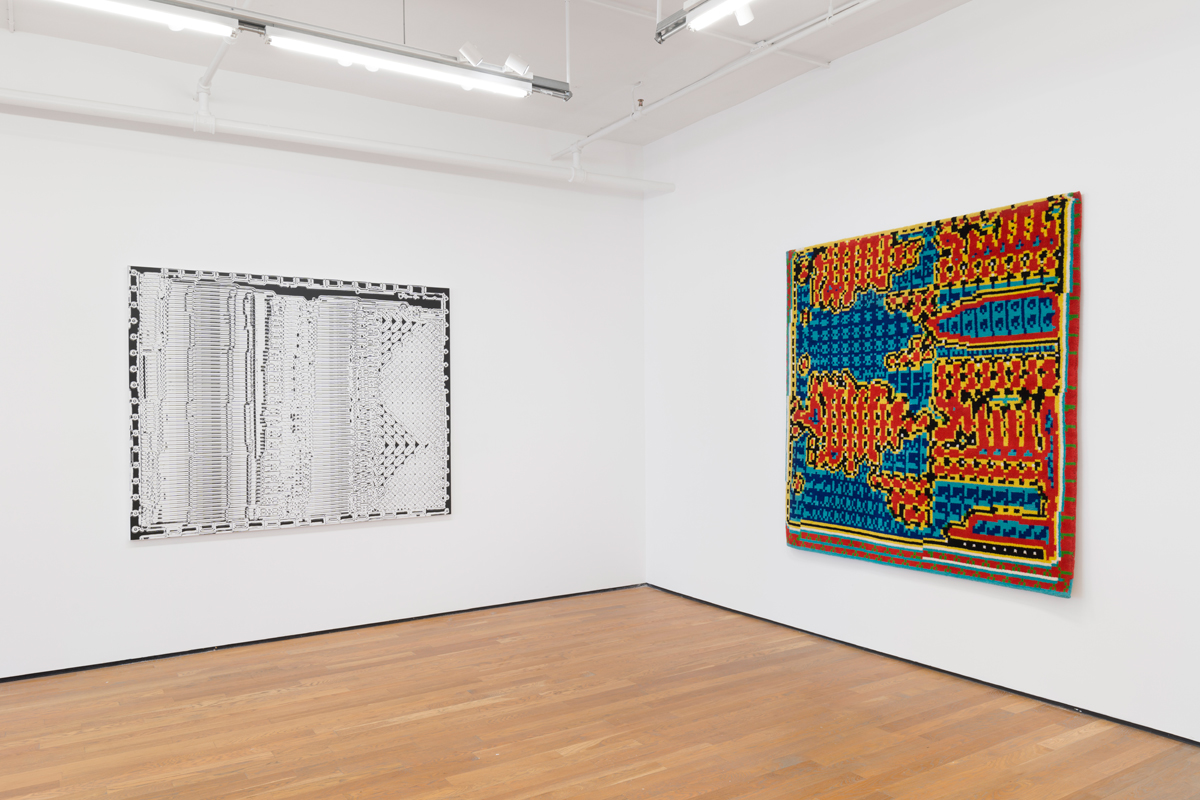
Travess Smalley: Number colors burn randomly, installation view. Courtesy the artist and Foxy Production. Photo: Charles Benton. Pictured, left: Flowform, 2023. Right: Rippleshift, Pixel Rug, 2023.
These two are among the latest in Smalley’s pixel rug series, which he began creating a couple of years ago, first as digital-only drawings, playing with the formal restrictions of pixel art in a combinatory fashion. Smalley writes custom scripts for Adobe Photoshop that use random numbers to effect an endless array of loosely rhythmic patterns. Images thus cultivated were selected and reshaped by the artist into a range of formats—Twitter PNG files, tradeable NFTs, a Game-Boy slideshow—but only later became instantiated in fabric, realizing the potential of their original nomenclature. To manufacture Ditherwave and Rippleshift, Smalley worked with Nitya Exports, a firm of weavers in northern India. The plant dyes and knotty handmade textures add further layers of optical reverberation to the labyrinthine digital designs.

Travess Smalley, Networkbraid, 2023. Courtesy the artist and Foxy Production. Photo: Charles Benton.
The three screen prints are nearly as sizable as the rugs. Here, set on white artificial canvas grounds, we encounter oblong stretches of inky lines that form chaotic tessellations. If the rugs exude an organic warmth, the screen prints veer toward the eerie and uncanny, offering weird admixtures of Bridget Riley, H. R. Giger, and magnified microchip diagrams, wherein psychedelic skeins of ultra-fine lines tease the eye to produce a phantom silver glow. In Flowform, stacks of those thin oblong forms jut like shores against seas of geometric blobs, bordered by repetitions of thicker black that resemble the negative space of a photographic frame. Terrainstamp mirrors the pseudo-geography of Rippleshift, Pixel Rug in black and white, looking something like a mutated map lifted from a mid-’90s computer game. The trippiest and most deep-fried of the trio is Networkbraid, a ghostly Rorschach test, a fungal glitchscape, whose intricacies reveal innumerable strata of remediation and refiguring.
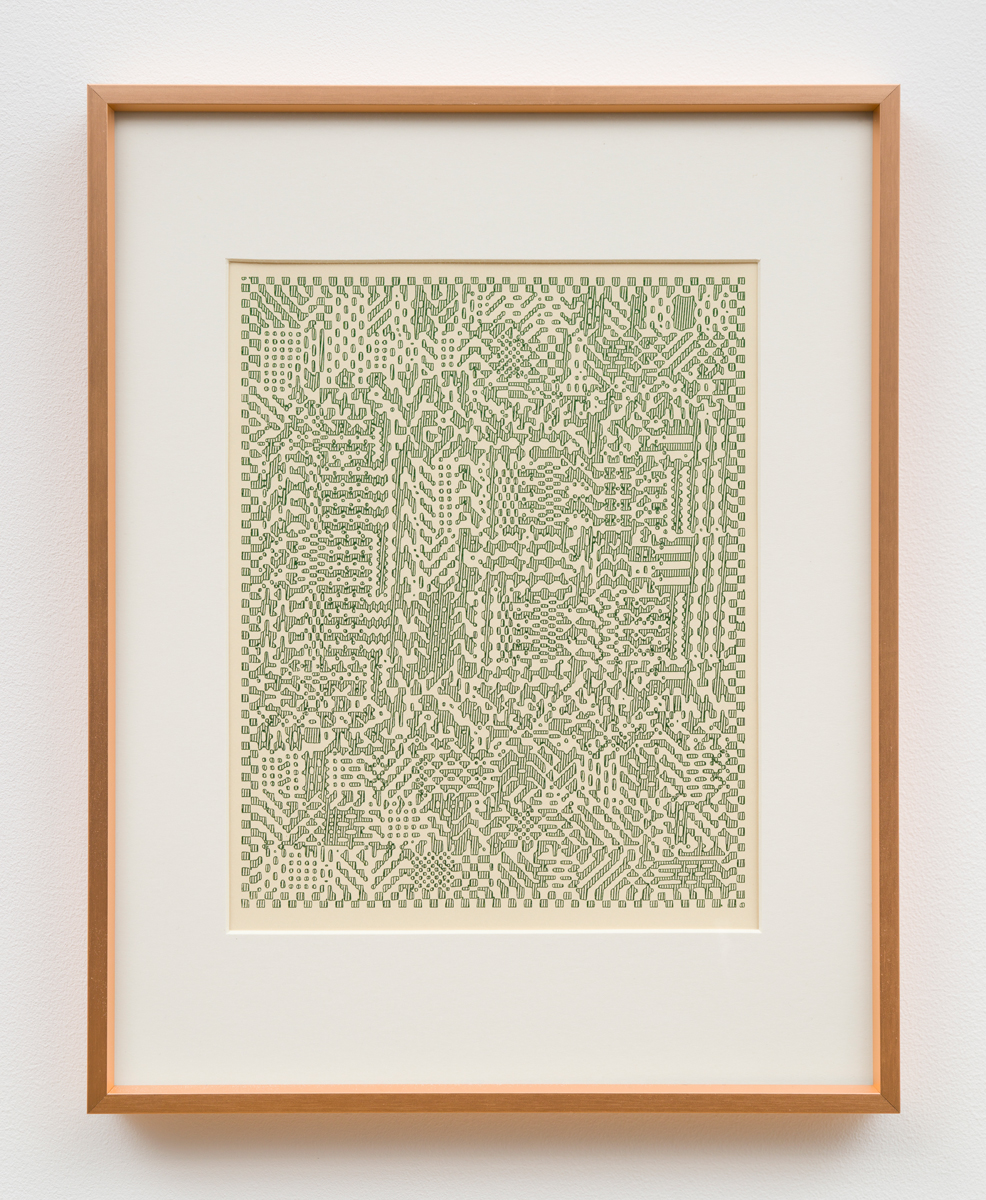
Travess Smalley, 33_Plotter_Foil_Drawing_03_17_23_01.bmp, 2023. Courtesy the artist and Foxy Production. Photo: Charles Benton.
More intimately folio-size, the foil drawings are given file-name titles like 33_Plotter_Foil_Drawing_03_17_23_01.bmp and 35_Plotter_Foil_Drawing_03_18_23_02.bmp, indicating that these are six iterations chosen from an ongoing process. Each bears a unique line drawing in the style of Smalley’s larger works. Although they were robotically sketched by a computerized pen-plotter, their scale and format nevertheless suggest the manual; seeing them immediately brought to mind Walter M. Miller Jr.’s postapocalyptic novel A Canticle for Leibowitz (1959), in which far-future monks preserve circuit diagrams and arithmetic tables by copying them as illuminated manuscripts.
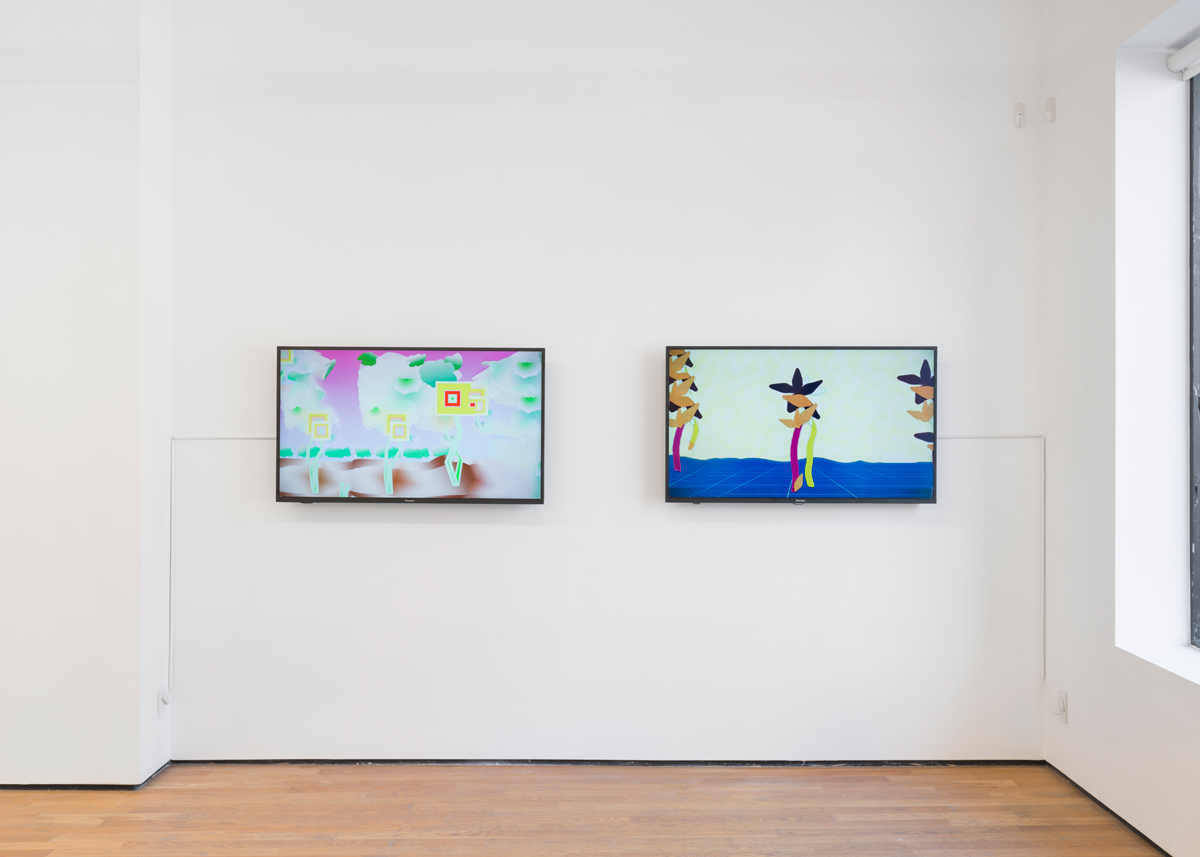
Travess Smalley: Number colors burn randomly, installation view. Courtesy the artist and Foxy Production. Photo: Charles Benton. Pictured, left: Chanceflower v3, 2023. Right: Chanceflower v9, 2023.
Next to these fine-art luxury objects are the two relatively humble videos, Chanceflower v3 and Chanceflower v9, loops of five and twenty-two minutes, respectively. These were created through software Smalley designed to continuously yield clumsy approximations of landscapes with flowers. The results are charming and vulnerable, with blocky stems of unnatural colors holding up square blooms atop a surface that flickers with wire-frame grid, every element of the vegetation, earth, and sky popping in and out of existence with a gentle rhythm. The floral figures allude to what Smalley calls the “seeds of chance” that prompt his algorithms, while also serving as emblems that synthesize the organic, the mathematical, and the aesthetic. In his writing, the artist places his work in a long lineage of creation through chance operations, reaching back past Fluxus and Dada all the way to ancient games of dice. Nonetheless, in his neo-cybernetic approach to working with generative software, Smalley seems to be sussing out how artmaking might evolve in a culture increasingly determined by more powerful and extractive versions of the same predictive systems.
Ed Halter is a founder and director of Light Industry, a venue for cinema in all its forms in Brooklyn, New York, and Critic in Residence at Bard College in Annandale-on-Hudson, New York.